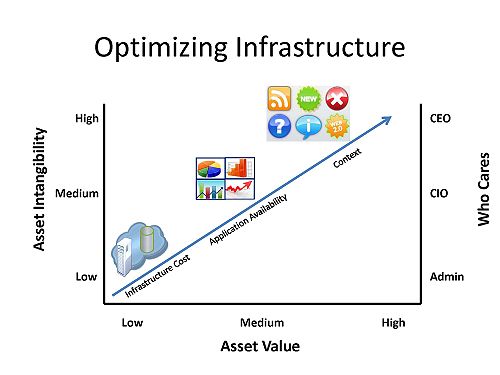Home
From Wikibon
| Line 32: | Line 32: | ||
*'''[[Pitfalls of compressing online storage |Pitfalls of Compressing On-line Storage]]''' | *'''[[Pitfalls of compressing online storage |Pitfalls of Compressing On-line Storage]]''' | ||
| - | |||
| - | |||
| - | |||
| - | |||
| - | |||
| - | |||
| - | |||
| - | |||
| - | |||
| - | |||
| - | |||
| - | |||
| - | |||
Revision as of 01:54, 1 October 2009
Latest Peer Incite Research:
Wikibon Highlights:
NEW Wikibon Research:
WikitipMaximizing Information ValueThe following notes respond to the Wikibon Mar 23rd Peer Incite: Should Function Reside in the Infrastructure or Application Stacks As I listened to the conversation and reviewed the data Wikibon collected, it seemed to me that we were framing value maximization. Infrastructure comparisons are certainly a valid way to go, but I think maximizing the value of information to corporations is a more relevant orientation. The value of infrastructure pales in comparison to the actual and opportunity cost of information. One reason to move function to applications is to maximize the value of information in ways that devices in infrastructure or even collections of devices or collections of infrastructure could never achieve. However, if the real goal is maximizing value, then we have to examine the mechanism by which value is added. Business value is driven by utilizing information to increase revenues, lower costs, better manage the competition, and create unique pools of value. Consequently, I came up with the following picture inspired by the Wikibon discussion: Uniquely identifying information One need corporations have is to be able to discover and verify that multiple physical copies of information stored on the corporate network each with different paths and timestamps have, in fact, the same information content. This is essential to enabling an organization to maintain a complete inventory of all its information and the copies or derivatives of that information. A related need is to group and classify this information and track the interrelationships between information items and the information groupings that have been established. For example, information may be grouped to reflect business transaction or specific information management policy. This grouping and classification means that beyond simply determining that information is consistent with policy, you also need to ensure that all the related information is also compliant. One specific, illustrative example is provided by a category called “Customer Order”. All information related to each customer order may have an attribute called “Customer Name” or some other unique identifier that would be helpful for information tracking.
Mike Alvarado
Action Item: Footnotes: |
Featured Case StudyFinancial giant goes greenThe corporate IT group of a very large, worldwide financial organization with 100,000 employees, has initiated an ongoing “greening” process. This is focused largely on reducing energy use both to decrease the corporation's carbon footprint while creating a net savings in operational costs over the lifetime of new, more energy-efficient equipment, including new storage systems. |
|
Featured How-To Note |
Planning a Green Storage InitiativeFluctuating energy prices have heightened electricity and energy consumption as a major issue within the technology community. IT is a significant consumer of energy and IT energy costs have been rising disproportionately because of continued investment in denser IT equipment. Estimates from the EPA and others indicate that IT will account for 3% of energy consumption by 2012. | |||




